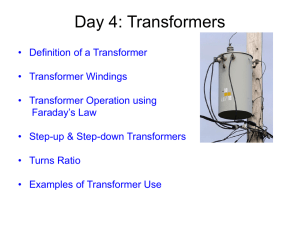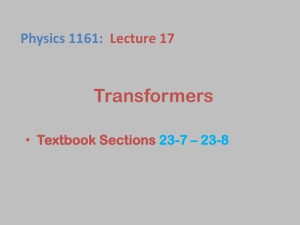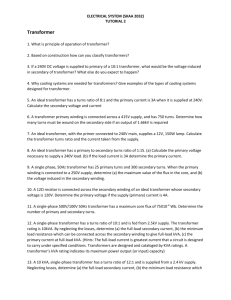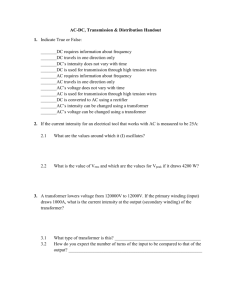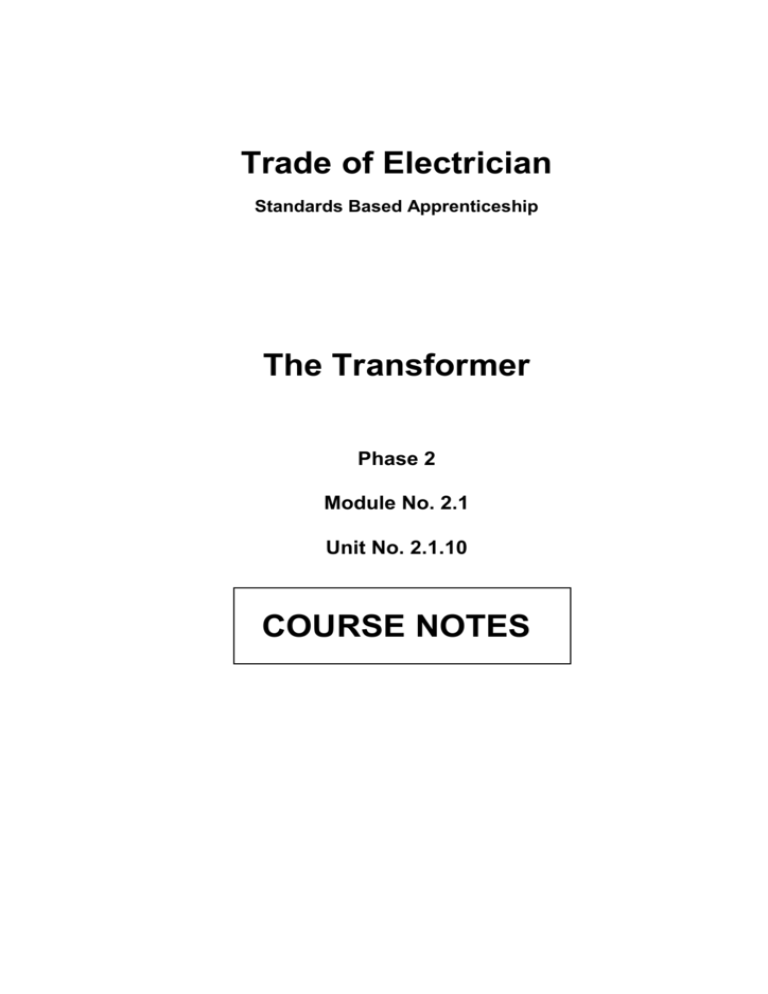
Trade of Electrician
Standards Based Apprenticeship
The Transformer
Phase 2
Module No. 2.1
Unit No. 2.1.10
COURSE NOTES
SOLAS
Electrical Course Notes - Unit 2.1.10
Created by Gerry Ryan - Galway TC
Revision 1 April 2000 by
Gerry Ryan - Galway TC
John Watters - Sligo TC
Revision 2 Nov. 2002 by
Gerry Ryan - Galway TC
Chris Ludlow - DundalkTC
Revision 3 Aug 2006 by
Chris Ludlow - DundalkTC
Revision 4, November 2013
SOLAS
Published by
27-33 Upper Baggot Street
Dublin 4
Ireland
© SOLAS - 2013
All rights reserved. No part of this publication may be reproduced, stored in a retrieval system or
transmitted in any form or by any means, electronic, mechanical, photocopying, recording or otherwise, without the
prior permission of the copyright owner.
2
Revision 4, November 2013
SOLAS
Electrical Course Notes - Unit 2.1.10
Table of Contents
INTRODUCTION.......................................................................................................................................... 4
THE TRANSFORMER ................................................................................................................................. 5
TRANSFORMER SYMBOLS ...................................................................................................................... 5
TRANSFORMER CONSTRUCTION ......................................................................................................... 6
THE TRANSFORMER PRINCIPLE .......................................................................................................... 7
TURNS AND VOLTAGE RATIO................................................................................................................ 9
STEP-DOWN TRANSFORMER ............................................................................................................... 10
STEP-UP TRANSFORMER ....................................................................................................................... 11
CURRENT RATIO ...................................................................................................................................... 12
POWER TRANSFER IN TRANSFORMERS .......................................................................................... 14
POWER RATING OF TRANSFORMERS ............................................................................................... 15
TRANSFORMER LOSSES ........................................................................................................................ 16
TRANSFORMER EFFICIENCY............................................................................................................... 16
RESISTANCE TEST ON A TRANSFORMER ........................................................................................ 17
INSULATION RESISTANCE TEST ON A TRANSFORMER .............................................................. 18
3
Revision 4, November 2013
SOLAS
Electrical Course Notes - Unit 2.1.10
Introduction
Welcome to this section of your course, which is designed to introduce you the learner, to the
transformer.
Objectives
By the end of this unit you will be able to:
Recognise and use appropriate symbols
Understand the principle of the transformer
State the relationship between turns ratio, voltage ratio and current ratio
Explain the difference between a step down and a step up transformer
Select a suitable power rating for a given load
Test transformer winding resistance and insulation resistance
Reasons
The transformer is a very widely used piece of electrical equipment. The importance of
understanding how it operates cannot be over emphasised.
4
Revision 4, November 2013
SOLAS
Electrical Course Notes - Unit 2.1.10
The Transformer
A transformer is an electrical device used to change the value of an alternating voltage.
Transformers are widely used in electrical work. They are encountered daily, in industrial,
commercial and domestic situations. They vary in size from miniature units used in electronics
to huge units used in power stations. The efficient transmission and distribution of electricity
throughout the country would be impossible without the use of power transformers.
Transformers are also used for safety reasons on construction sites when using power tools and
in domestic bathroom situations in shaver units. They are used in doorbell operation and also to
power electronic equipment, battery chargers, televisions, computers, alarm systems, etc.
Transformers vary considerably in construction, size and shape depending on their application.
All transformers rely on the principle of mutual inductance for their operation. Mutual
inductance was discussed in detail in Unit 2.1.6 Magnetism, Electromagnetism and
Electromagnetic Induction.
Transformer Symbols
Architectural Symbols
Circuit symbols
Figure 1
5
Revision 4, November 2013
SOLAS
Electrical Course Notes - Unit 2.1.10
Transformer Construction
A transformer consists of two coils of wire called windings, which are wound onto a common
iron core. The wire used in the two windings, primary and secondary, is coated with an
insulating varnish. Both coils are wound onto, but insulated from the iron core.
See Figure 2.
Primary Winding
Secondary Winding
Applied Alternating
Current Supply
Alternating Induced
EMF
Figure 2
6
Revision 4, November 2013
SOLAS
Electrical Course Notes - Unit 2.1.10
The Transformer Principle
When a conductor or coil is moved in a stationary magnetic field it cuts the lines of magnetic
flux and an EMF is induced in the conductor or coil. This same principle also applies when a
conductor is held stationary and the magnetic flux is made to change or vary.
Now consider an alternating current applied to a stationary coil. A magnetic field will build up
and collapse in the coil, continually rising and falling in harmony with the applied AC current
as shown in Figure 3.
Alternating flux
continually
building up,
collapsing
and changing
in polarity
AC Supply
Figure 3
If a second coil ( coil 2 ) is placed close to the first coil ( coil 1 ) the alternating magnetic flux in
coil 1 links with coil 2. See Figure 4. This results in an EMF being induced in coil 2. This is a
process known as mutual induction.
Coil 1
Coil 2
Applied Alternating
Current Supply
Alternating Induced
EMF
Figure 4
7
Revision 4, November 2013
SOLAS
Electrical Course Notes - Unit 2.1.10
If coil 1 and coil 2 are mounted on an iron core the magnetic flux around both coils will be
concentrated. This arrangement of coils and an iron core form the complete device known as a
transformer. See Figure 5.
Primary Winding
Secondary Winding
Applied Alternating
Current Supply
Alternating Induced
EMF
Lines of Flux set up by Primary Winding
Figure 5
The input coil of a transformer is fed from the AC supply and is called the primary winding.
The output coil, to which the load is connected, is called the secondary winding.
It is important to remember that there is no electrical connection between the primary winding
and the secondary winding of a transformer. The only common link between the two windings
is the magnetic field.
8
Revision 4, November 2013
SOLAS
Electrical Course Notes - Unit 2.1.10
Turns and Voltage Ratio
The relationship between the number of primary winding turns (N1) and the number of
secondary winding turns (N2) together with the primary input voltage (U1) and the secondary
output voltage (U2) can be expressed as a ratio or equation as shown below.
U1
N1
=
U2
N2
Where:
N1
N2
U1
U2
=
=
=
=
Number of Primary Winding turns
Number of Secondary Winding turns
Primary Input Voltage
Secondary Output Voltage
This formula can be transformed to find any one unknown provided the other three are known.
U2 x N1
U1
U1 x N2
=
U2
=
N2
N1
U1 x N2
N1
U2 x N1
=
N2
=
U2
U1
Example:
A transformer has 100 turns on the primary winding and 20 turns on the secondary winding. If
the primary voltage is 230VAC, what is the secondary voltage?
Solution
U1
N1
=
U2
N2
U2 x N1
=
U2
=
U1 x N2
U1 x N2
N1
230 x 20
U2
=
100
U2
=
46 Volts.
The transformer referred to in this example is a step-down transformer and is said to have a
turns ratio of 100:20. This may be expressed as a ratio of 5:1.
Primary turns are always stated first.
9
Revision 4, November 2013
SOLAS
Electrical Course Notes - Unit 2.1.10
Step-Down Transformer
Because the same magnetic flux lines cut both coils of a transformer, the induced EMF in the
secondary winding, is proportional to the number of turns on both the primary and secondary
windings.
If the number of turns on the secondary winding is less than the number of turns on the primary
winding, then the secondary output voltage will be less than the primary input voltage. This type
of transformer is called a step-down transformer and is illustrated in Figure 6.
Primary Winding
Secondary Winding
Applied Alternating
Current Supply
Having less turns than
the Primary Winding
Step-Down Transformer
Figure 6
Example
A transformer has 2660 turns on the primary side and 140 turns on the secondary side. If the
primary voltage is 230 Volts AC, find the secondary voltage?
Solution
U1
N1
=
U2
N2
U1 x N2
U2
=
N1
230 x 140
U2
=
2660
U2
=
12.10 Volts.
This is a step down transformer and is said to have a turns ratio of 2,660:140 or 19:1.
10
Revision 4, November 2013
SOLAS
Electrical Course Notes - Unit 2.1.10
Step-Up Transformer
If the number of turns on the secondary winding of a transformer is greater than the number of
turns on the primary winding, then the secondary output voltage will be greater than the primary
input voltage. This type of transformer is called a step-up transformer and is illustrated in
Figure 7.
Primary Winding
Secondary Winding
Applied Alternating
Current Supply
Having more turns than
the Primary Winding
Step-Up Transformer
Figure 7
Example:
A transformer has 200 turns on the primary winding and 1200 turns on the secondary winding.
If the primary voltage is 230VAC, what is the secondary voltage?
Solution
U1
N1
=
U2
N2
U1 x N2
U2
=
N1
230 x 1200
U2
=
200
U2
=
1380 Volts.
This is a step-up transformer and is said to have a turns ratio of 200:1200 or 1:6.
11
Revision 4, November 2013
SOLAS
Electrical Course Notes - Unit 2.1.10
Current Ratio
With zero losses assumed for a transformer, the power in the secondary output winding equals
the power in the primary input winding. This relationship can be expressed as a ratio or
equation as shown below.
Power Input
U1 x I1
=
Power Output
=
U2 x I2
or
U1
I2
=
U2
I1
From the above equations it can be seen that the current ratio is the inverse of the voltage ratio,
that is, a voltage step-up in the secondary winding results in a current step-down in the
secondary winding, and vice versa.
Example:
A transformer has a primary voltage of 230 Volts and a secondary voltage of 115 Volts. A
current of 6.5 Amps is flowing in the primary winding. Find the load on the secondary winding.
U1
I2
=
U2
I1
U1 x I1
I2
=
U2
230 x 6.5
I2
=
115
I2
=
13 Amps
The secondary winding does not generate its own power but rather takes it from the primary
winding. Therefore, the current step-up or step-down is in terms of the secondary current. The
primary current is determined by the load resistance across the secondary winding. These points
are illustrated by the following example.
12
Revision 4, November 2013
SOLAS
Electrical Course Notes - Unit 2.1.10
Example:
A transformer with a 20:1 voltage ratio ( step-down ), provides a secondary voltage of 6 Volts
AC across a 0.6 Ohm load resistor. Calculate the following values:
1. Secondary Current ( I2 )
2. Primary Current ( I1 )
Solution
I1
I2
AC Volts
6 Volts
0.6
Figure 8
(1)
N1
I2
=
N2
6
I2
=
0.6
I2
=
U1
=
10 Amps
(2)
U2 x N1
N2
6 x 20
U1
=
1
U1
=
I1
=
120 Volts
U2 x I2
U1
6 x 10
I1
=
120
I1
=
0.5 Amp
13
Revision 4, November 2013
SOLAS
Electrical Course Notes - Unit 2.1.10
Power Transfer in Transformers
I1 = 0.5A
I2 = 10A
U1 = 120V
U2 = 6V
0.6
Figure 9
In Figure 9 we can now look at the circuit from the previous example, redrawn with the
calculated voltage and current values included. The power in the primary winding of a
transformer transfers to the secondary. This is illustrated in the example below.
Power in Primary
=
Power in Secondary
U1 x I1
=
U2 x I2
120 x 0.5
=
6 x 10
60 VA
=
60 VA
Remember that the winding with the higher voltage has the lower current and the winding with
the lower voltage has the higher current. In the above example the voltage ratio is 20:1 while the
current ratio is 1:20. The secondary winding would need to be wound with wire of a larger cross
sectional area than that of the primary winding in order to carry the larger current.
Reflecting on Formulae
U1
N1
=
U2
N2
and
U1
I2
=
U2
I1
Therefore
U1
N1
=
U2
I2
=
N2
I1
And so
N1
I2
=
N2
I1
14
Revision 4, November 2013
SOLAS
Electrical Course Notes - Unit 2.1.10
Power Rating of Transformers
The power rating of a transformer may be calculated by multiplying the secondary AC voltage
by the full load secondary AC current.
Rating
=
Secondary Voltage x Secondary Current
Rating
=
V x A ( U2 x I2 )
Rating
=
VA
A rating quoted in VA will apply to small transformers. The rating of larger transformers will
be quoted in kVA or MVA
VA
That is
=
kVA
=
MVA
=
MVA
1000
VA
or
1000,000
kVA
or
1000
15
Revision 4, November 2013
SOLAS
Electrical Course Notes - Unit 2.1.10
Transformer Losses
Iron Losses in a Transformer
Eddy currents are induced into the transformer core. These unwanted eddy currents, cause
heating of the core. They represent a loss in the transformer and are referred to as iron losses.
The iron core is made up of steel laminations, to reduce eddy currents to a minimum. Silicon
steel is generally used as its magnetism is easily reversed.
Copper Losses in a Transformer
Copper losses are due to, current flowing through the resistance of the windings, and are often
referred to as the I2R losses ( P = I2 x R ). The greater the current flow through the windings, the
greater the copper losses.
Transformer Efficiency
A transformer has no moving parts and is a highly efficient device. Normal transformer
efficiency is around 98%. In general, the larger the transformer the higher its efficiency.
Efficiency is defined as the ratio of power output to power input.
Warning
Great care must be exercised when connecting the primary and secondary windings of
transformers.
The rated voltage of the windings must never be exceeded otherwise damage will result to
equipment, property and may also present a danger to the Health and Safety of person(s).
16
Revision 4, November 2013
SOLAS
Electrical Course Notes - Unit 2.1.10
Resistance Test on a Transformer
Connect an ohmmeter across the two ends of the primary winding of the transformer and record
the resistance. See Figure 10.
Primary
Winding
Secondary
Winding
Figure 10
Connect an ohmmeter across the two ends of the secondary winding of the transformer and
record the resistance. See Figure 11.
Primary
Winding
Secondary
Winding
Figure 11
Conclusion:
If an infinite resistance is obtained in either of the two tests this will indicate an open circuit in
that winding and hence non-function of the transformer.
The resistance values of both windings may differ quite substantially due to the difference in the
number of turns on each winding and also the difference in the cross sectional area of the wire
in the primary and secondary windings.
To determine if the resistance values measured are correct, the manufacturer’s specifications
will have to be obtained and both resistance readings compared.
17
Revision 4, November 2013
SOLAS
Electrical Course Notes - Unit 2.1.10
Insulation Resistance Test on a Transformer
Class 1 Transformer
Insulation resistance tests between each winding and earth
Temporary short for the duration of the test
Primary
Winding
Secondary
Winding
M 500V
Test 1
Primary Winding to core
Test 2
Secondary winding to core
Insulation resistance test between windings
Temporary short for the duration of the test
Primary
Winding
Secondary
Winding
M 500V
The minimum insulation resistance value accepted in each of the above tests is 2M.
A 500V Insulation Resistance Test is suitable for 110 – 400 Volt transformers.
18
Revision 4, November 2013
SOLAS
Electrical Course Notes - Unit 2.1.10
Class 2 Transformer
Double Insulated Symbol
Insulation Resistance Test Between Windings
Temporary short for the duration of the test
Primary
Winding
Secondary
Winding
M 500V
The minimum insulation resistance value accepted in the test is 2 M.
19
Revision 4, November 2013


